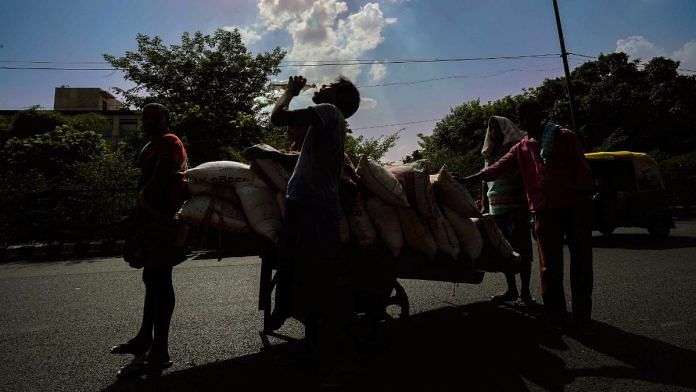New Delhi: An intense heatwave has gripped northwest and central India, with maximum daytime temperatures in some areas soaring to nearly 50 degrees Celsius. Weather scientists have, however, say that the high nighttime temperatures that are being recorded in these areas are the most worrying.
According to India Meteorological Department (IMD) data, on 21 May, most observatories in the national capital recorded maximum temperatures above 40 degrees Celsius. However, the minimum temperatures were also alarmingly high.
Delhi’s Najafgarh Wednesday recorded a minimum temperature of 33.7 degrees Celsius — 7 degrees higher than what is considered normal for this time of the year.
The rest of the city has also been recording warmer nighttime temperatures.
The minimum temperature at the Safdarjung weather station, which provides representative data for the entire city, reached 30.9 degrees Celsius. This was 4.2 degrees Celsius above normal. At Palam, the minimum temperature was 30.4 degrees Celsius, a spike of 3.3 degrees above the normal mark.
Also read: Dust storms hit Delhi & Mumbai, then warnings came — why they couldn’t be predicted in time
What do high night temperatures indicate?
Weather scientists explained that the daytime temperatures, represented by the maximum temperatures, indicate the extremity of heat recorded. The nighttime temperatures, however, tell us how much cooling is happening.
When minimum temperatures are high, the surface does not cool down. A region’s heat stress increases when this trend continues for a long period.
A senior scientist at the IMD who wished to not be named, explained that during May and June, considered the peak summer months in northwest and central India, people get some respite from the grueling daytime temperatures after sundown. The narrower the gap between maximum and minimum temperatures, the more extreme the heatwave conditions become.
“High minimum temperatures for a prolonged period pose a significant health risk. When both maximum and minimum temperatures are elevated, the temperature cycle is disrupted. This leads to intensified heat and a higher likelihood of heat-related illnesses, particularly among the vulnerable sections of the population,” the official warned.
What is causing such high temperatures?
Weathermen warn that similar conditions are expected to continue in the region at least till May 31.
Mahesh Palawat, Vice-President (meteorology and climate change) at Skymet Weather, a private weather forecasting agency, said no weather systems are in sight that could bring relief to the region. Hot westerly winds from the northern latitude will continue to increase the day and night temperatures.
“There is a low-pressure area developing around the Bay of Bengal, which is preventing any weather system from reaching this side and facilitating the flow of westerly winds. There is no relief likely, at least till the end of this month,” he said.
Experts have observed that minimum temperatures in the region have been increasing over the last decade.
IMD scientists say that in May, maximum temperatures tend to peak across the country, with temperatures in many parts of northwest and central India crossing the 45 degrees Celsius mark. There are also spells of intense heat when the minimum temperatures tend to rise.
However, such levels of heating could be a result of the urban heat island effect. When an area is heavily concretised, natural cooling tends to become slower. Heat during the day tends to get trapped in a space and circulates, making the area feel warmer.
“May and June are the peak summer months. By the end of May, we usually experience such conditions. This year there has been no aberration,” Palawat said.
Impact of heat stress on people
Such high temperatures, in the day and at night, for such a prolonged period can have deadly impact on people’s health. The worst impacted by such conditions are the vulnerable — senior sections, children and women. The homeless and those without air conditioning options are also severely impacted.
Health experts say that people must avoid stepping out during peak afternoon hours. Government agencies must also ensure that people without a roof are moved to shelter homes and their health is routinely monitored.
“The impacts of heat on health can range from minor rashes to more serious symptoms like dehydration, heat exhaustion and heat stroke. In extremely severe cases, heart attacks and brain strokes can also be experienced with prolonged exposure to intense heat,” said Dr Suranjit Chatterjee, senior consultant at Delhi’s Indraprastha Apollo Hospital.
(Edited by Zinnia Ray Chaudhuri)
Also read: India calls for study of melting ice caps, controlled tourism at Antarctic Treaty meet in Kochi



